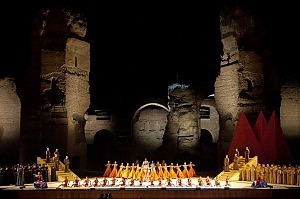Good to know....
Opera under the stars
 [Revised January 2025] Rome’s Opera House holds its summer opera and ballet season framed by the incredible ruins of the Baths of Caracalla (Terme di Caracalla), where you can enjoy opera under the stars. The performances feature the orchestra, chorus and the ballet company of the “Teatro dell’Opera di Roma” as well as international stars.
[Revised January 2025] Rome’s Opera House holds its summer opera and ballet season framed by the incredible ruins of the Baths of Caracalla (Terme di Caracalla), where you can enjoy opera under the stars. The performances feature the orchestra, chorus and the ballet company of the “Teatro dell’Opera di Roma” as well as international stars.
For over 80 years the monumental archaeological site has been a wonderful stage for unforgettable shows set up in a magical frame of antiquity: in fact it was the year 1937 when the Teatro dell’Opera started its summer season at the Caracalla Baths for the first time!
The Baths of Caracalla were one of the major spa complexes in ancient Rome, maybe the richest for its splendid decoration. The baths were in use until 537 when Vitige, King of the Goths, cut the aqueducts during the siege of Rome.
In the first half of the 19th century the palaestra was rediscovered and mosaics of athletes and sporting judges were removed (they are now in the Vatican Museums). Since then, non stop excavations have contributed to our knowledge of the monument revealing recently the underground galleries and a mithraeum.
Opera was invented in the Renaissance Florence by a group of intellectuals who aimed to recreate the Greek drama combining poetry and music: the “sung theatre” (il recitar cantando) was originally just poems read aloud to the accompaniment of few chords. Opera flourished during the Baroque era, becoming a real business, a new world populated by impresarios, librettists, divas and castratos (male singers who were evicted at the age of 8 to prevent their voice from breaking during puberty and giving them a great vocal extension from sopranos to tenor voices… This cruel practice was illegal, but perpetrated among the poor who hoped their children would make good money from Opera).
In Rome the Counter Reformation stopped the development of the Opera which was only accepted in the 19th century when it had reached every social class, not just the aristocracy. The Teatro Argentina (still in activity!) became the centre of the city’s musical life and here Rossini performed his first “Barber of Seville” in 1816, followed by Verdi’s “Trovatore” in 1853.
The Rome Opera House opened in 1880, under the name of Teatro Costanzi from his patron, an hotelier. It became a public theatre in 1926 and was massively restored, boasting a wide stage and the largest Murano crystal chandelier in Europe.
If you are not in Rome during the Summer Festival, check the Opera House program and do not hesitate to book a seat if you read “Tosca” on it: it is the most Roman of all operas, a story of jealousy, obsession and lost love set in Rome during the tense period of the French Revolution and the fall of the first Roman Republic. The plot is played out over 24 hours in three important Roman monuments as backdrops, which can be the stops of a nice walk in the centre: the church of Sant’Andrea della Valle, Palazzo Farnese and Castel Sant’Angelo.
